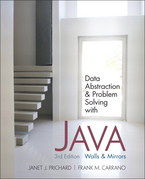



java.lang.Integer
Objects. Starting with an empty queue, use the add(E e) method to add
java.lang.Integer objects representing the numbers
(1 <= n <= 100,000) to the Queue.
java.lang.Integer
Objects that is fully populated with java.lang.Integer objects
representing the numbers (1 <= n <= 100,000) in the Queue. De-queue all
objects using the remove() method. Make sure to verify that the
java.lang.Integer objects are in the expected FIFO order.
java.lang.String
Objects that is fully populated with java.lang.String objects
representing the strings ("String 1" <= s <= "String 100") in the Queue.
Use the Iterator() method to obtain a java.util.Iterator
object. Use the java.util.Iterator object to display the strings
in the queue.
java.lang.String
Objects that is fully populated with java.lang.String objects
representing the strings ("String 1" <= s <= "String 100") in the Queue.
Use the Iterator() method to obtain a java.util.Iterator
object. Use the java.util.Iterator object to display and remove
the strings from the queue.
iterator.getNext() or
iterator.remove() if your underlying queue is being modified while
the iterator is in use?
Please submit the completed assignment on Blackboard. You must submit your Java programs as a zip file of your Eclipse project. The analysis must be a typed Microsoft Word file. No other forms of submission will be accepted.